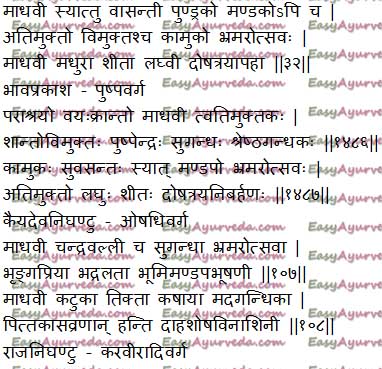Madhavi Lata (Hiptage benghalensis) – Uses, Remedies, Research, Side Effects
By Dr Renita D’Souza
Madhavi (Hiptage benghalensis) is a cooling Ayurvedic shrub with clusters of beautiful fragrant white yellowish flowers.
Table of Contents
Remedies, qualities, uses
Traditional Remedies of Madhvi lata
It is traditional used in the treatment of burning sensation, obesity, wounds, rheumatism, inflammation, pitta related disease, ulcers, skin diseases, etc
- Leaves are used in skin diseases. Leaf paste applied externally cure scabies.
- Bark is made used in indigestion, asthma and rheumatoid arthritis.
- To reduce belly fat, it is used with buttermilk or the seed kernel is given with honey.
- Plant decoction is given to women after childbirth.
- Flowers is taken with drinking water as a coolant.
- Master Sushruta mentioned the use of heart wood internally in obesity, jaundice, urethral discharges and externally in chronic skin diseases.
- Seed oil is given internally for flatulence, biliousness and for increase slimy secretions of the body
It is known to be a cardiac tonic. As it is considered as expectorant, it is also made used in asthma and cough.
Botanical Name – Hiptage benghalensis
Synonyms – Hiptage madablota
Family – Malpighiaceae
Medicinal Qualities of Madavi
Taste – sweet (madhura)-B.N; Pungent (katu), Tiktha (bitter) and Astringent (kashaya) R.N
Virya (potency) – Cold (shita)
Qualities
Laghu – light to digest
Effects on Tridosha
It balances all three doshas Vata, Pitta and Kapha dosha
Therapeutic Uses
Kasa – cough
Vrana – wounds
Daha – burning sensation
Shosha – muscle wasting, emaciation
Part Used
Bark, leaf, flower, seed, stem
Morphology, pharmacology, research
Morphology of Hiptage benghalensis
Hiptage benghalensis is climbing shrub with clusters of fragrant white to yellowish flower. Leaves are lanceolate to ovate-lanceolate, approximately 20 cm long. Fruits 2–5 cm, 3 papery wings.
Pharmacological Activity of Hiptage benghalensis
the plant possess antibacterial, anti fungal, anti-diabetic, anti-inflammatory, anti-cancerous, antimutagenic and hepatoprotective activity
Research
1. Analgesic and Anti inflammatory Activity – A study was conducted to evaluate analgesic and anti-inflammatory activities of ethanol extract of Hiptage benghalensis and the study concludes significant anti-inflammatory and analgesic properties of leaf of Hiptage benghalensis.
2. Anti-asthmatic Activity – Study was done to investigate anti-asthmatic activity of leaves of Hiptage benghalensis (L) Kurzz on early and late phase of asthma have proved that Hiptage benghalensis (L) Kurzz have anti-asthmatic activity on both early and late stage of asthma.
3. Anti diabetic Activity – A study which focused on phytochemical screening and anti-diabetic efficacy of stem of Hiptage benghalensis (L) Kurz have proved its significant anti-diabetic activity as claimed in Ayurveda medicine.
4. A review article on Hiptage benghalensis (Madhavilata) as an Ayurvedic drug (read more)
Sanskrit verse, synonyms, chemistry

Sanskrit Synonyms
Vasanthi, Pundraka,, Mandaka,
Atimukta, Vimukthascha
Kaamuka, Bhramarothsava
Vayahkranta, Shantovimukthah
Pushpendra, Sugandha, Shresta gandhaka
Suvasanta
Chemical constituents
Hiptage benghalensis contains steroid, carbohydrate, flavonoid, alkaloid, tannin, phenol, mangiferin and terpenoids-compounds.
Interaction with medicines, supplements
Can this be used while taking Homeopathic medicine?
Yes. This product does not react with homeopathic medicine.
Can
this medicine be continued while taking supplements like multivitamin tablets,
Omega 3 fatty acids etc?
Yes. Generally, this product goes well with most
of the dietary supplements. However, if you are taking more than one product
per day, please consult your doctor for an opinion.
With western
medicines
Seek your
doctor’s advice if you are taking this product along with other western
(allopathic / modern) medicines. Some Ayurvedic herbs can interact with modern
medicine.
If both Ayurvedic and allopathic medicines are advised together, then it is
best to take Allopathic medicine first, wait for 30 minutes and then take the
Ayurvedic medicine.
Side effects, vernacular, distribution
Side Effects of Madhvi Lata
There are no recorded side effects of this herb.
However if taken in excess dose internally can cause stomach irritation and constipation due to its astringent property.
Names in different Languages
English Name – Clustered hiptage, Hiptage, Helicopter Flower
Hindi Name – Maadhavi, Madhavi lata
Marathi Name – Madhumaalati, Haladwail
Bengali Name – Maadhavi lata, Haldabel, Madhabilata
Gujarati Name – Ragathpitho, Madavi lata
Tamil Name – Adigam, Vasantakaala malligai
Telugu Name – Madavatoge, Madhavi tige, Maadhavi, Kurukkathi
Manipuri Name – Madhabi
Kannada Name – Madhvi, Madhavivasantadhuti
Malayalam Name – Sitampu
Assamese – Kerek-lata
Oriya – Boromali, Gorunda
Distribution
Hiptage benghalensis is found in Southern China, Taiwan, India, Nepal, Indonesia, Malaysia, Myanmar, Philippines, Sri Lanka and Thailand. It is found throughout India, predominantly in Western Ghats, Konkan, Deccan, Kumaon, Assam and Andaman island.
Classical categorisation
Bhavaprakasha Nighantu – Pushpa Varga
Kaiyadeva Nighantu – Aushadi Varga
Raja Nighantu – Karaviradi Varga
Scientific Classification
Kingdom – Plantae
Subkingdom – Trachiobionta
Division – Magnoliophyta
Class – Magnoliopsida Subclass : Rosidae Order : Polygalales Family : Malpighiaceae (Barbados cherry family) Genus : Hiptage Species : Hiptage benghalensis
Click to Consult Dr Renita D’Souza










